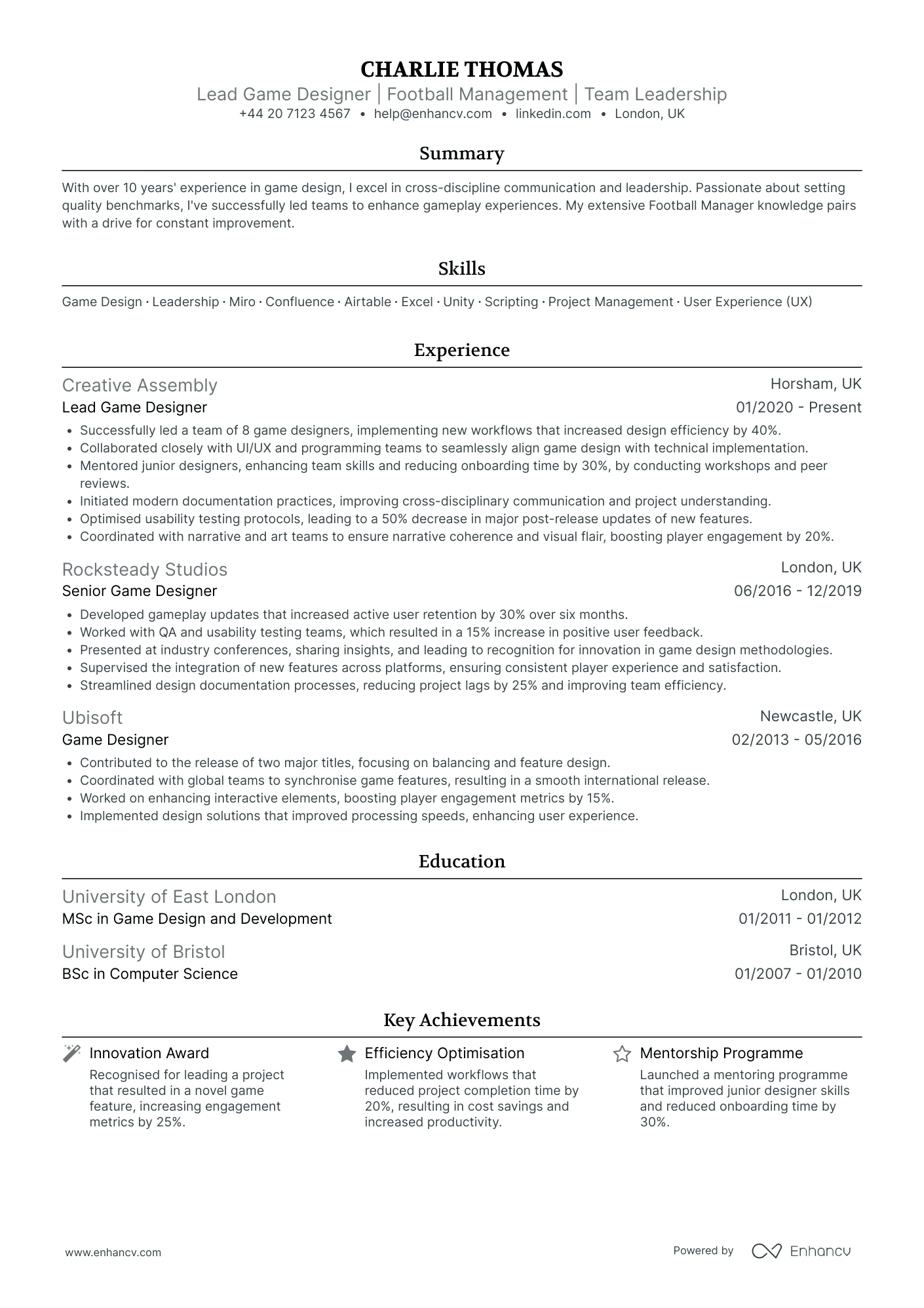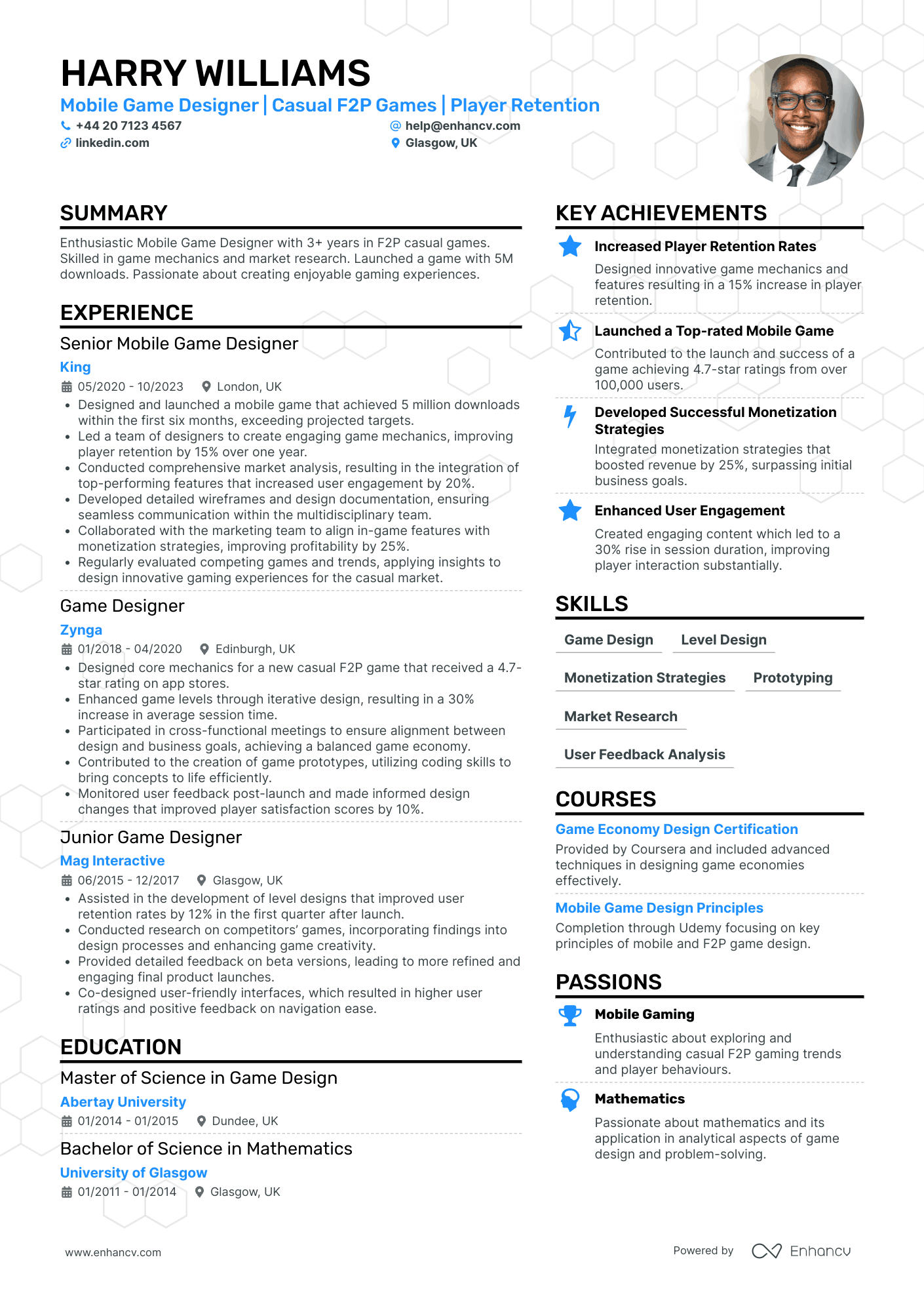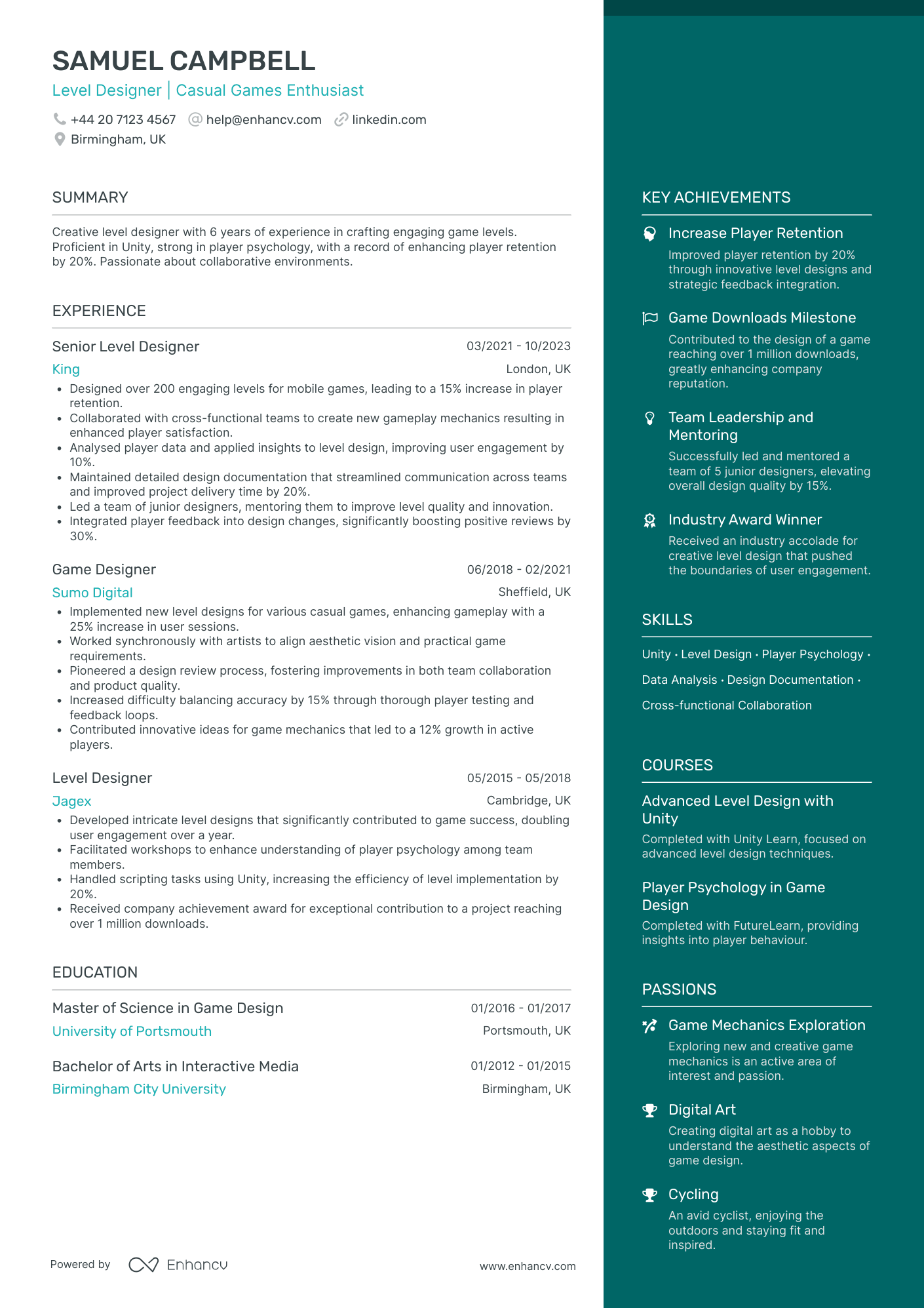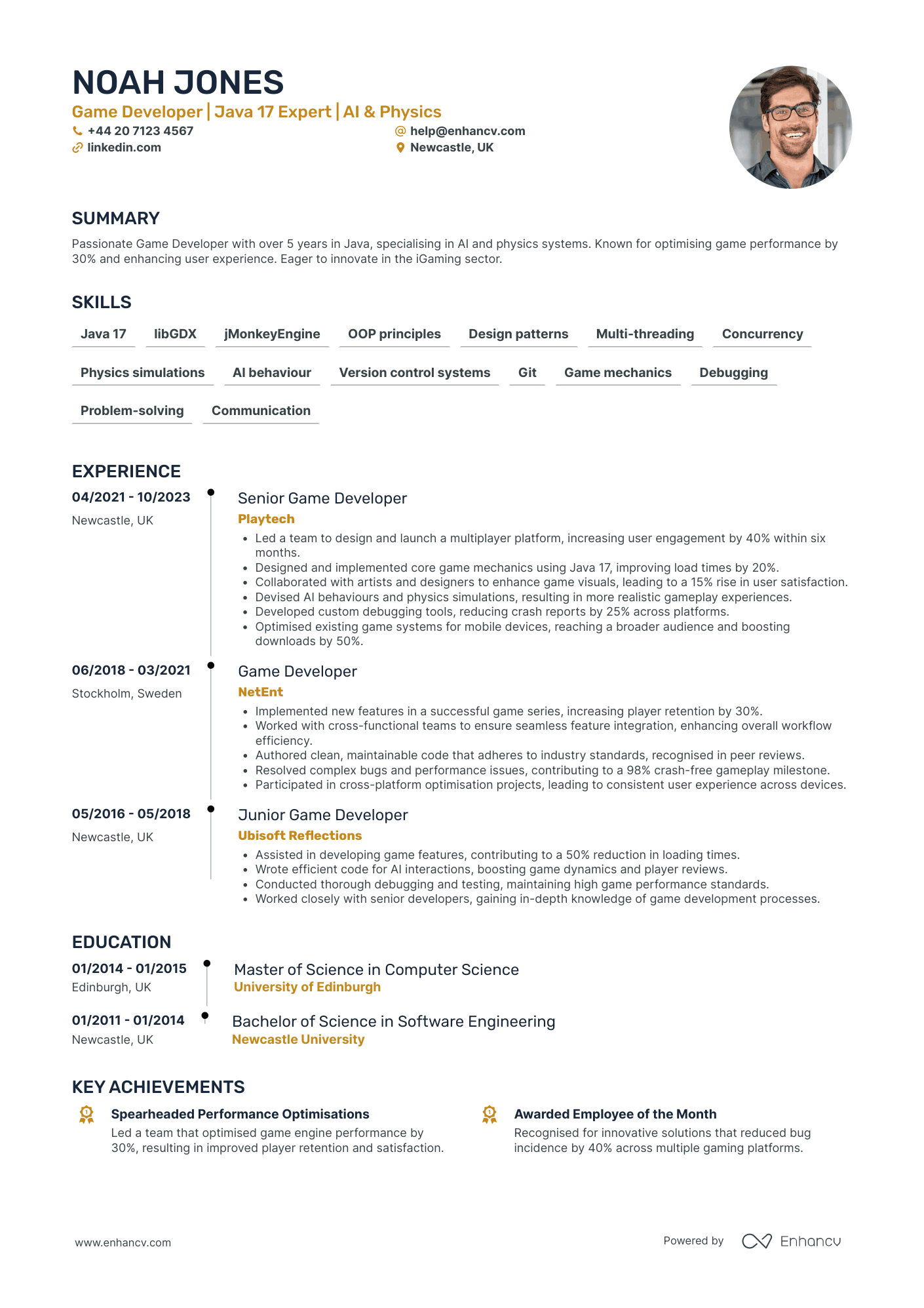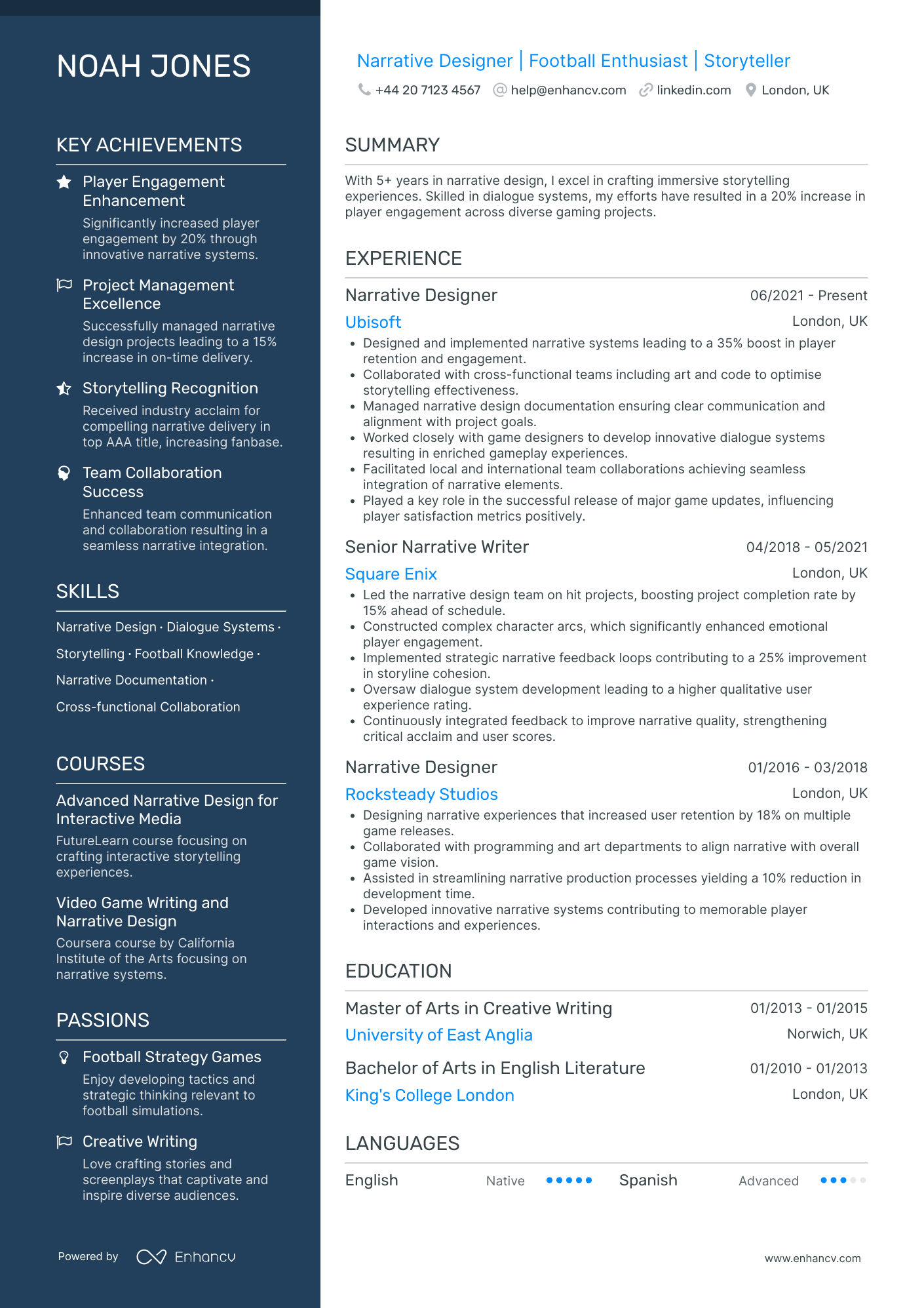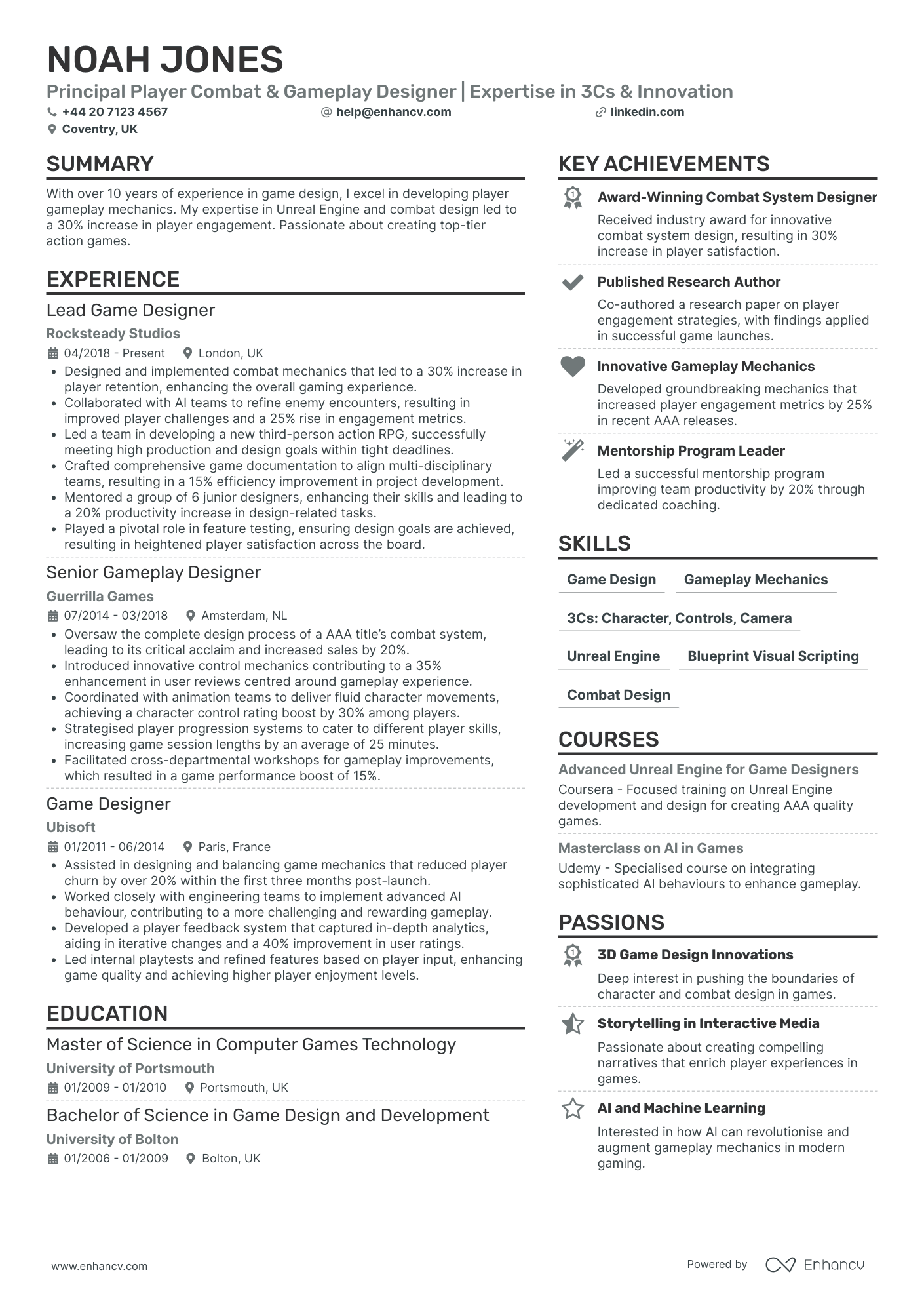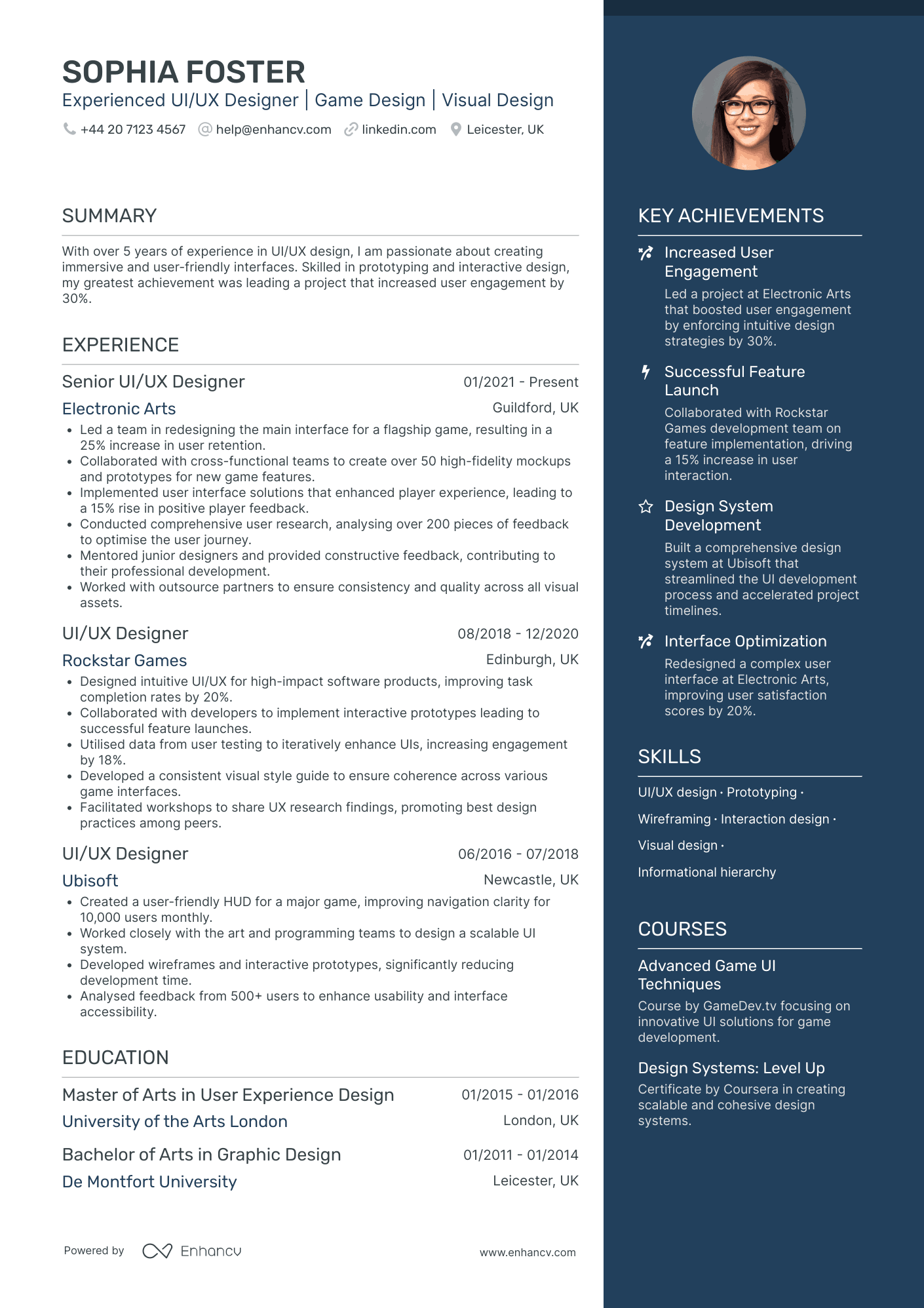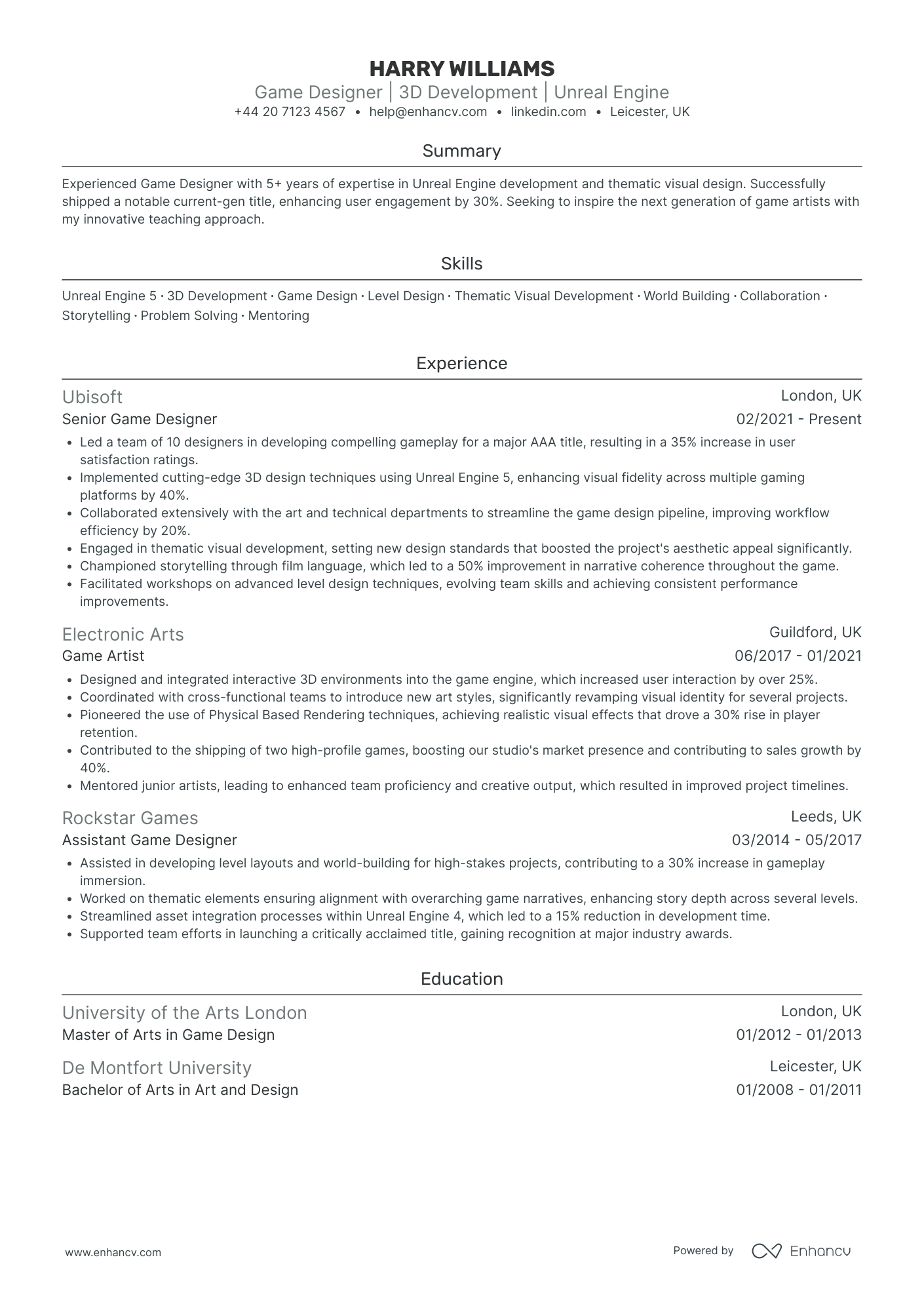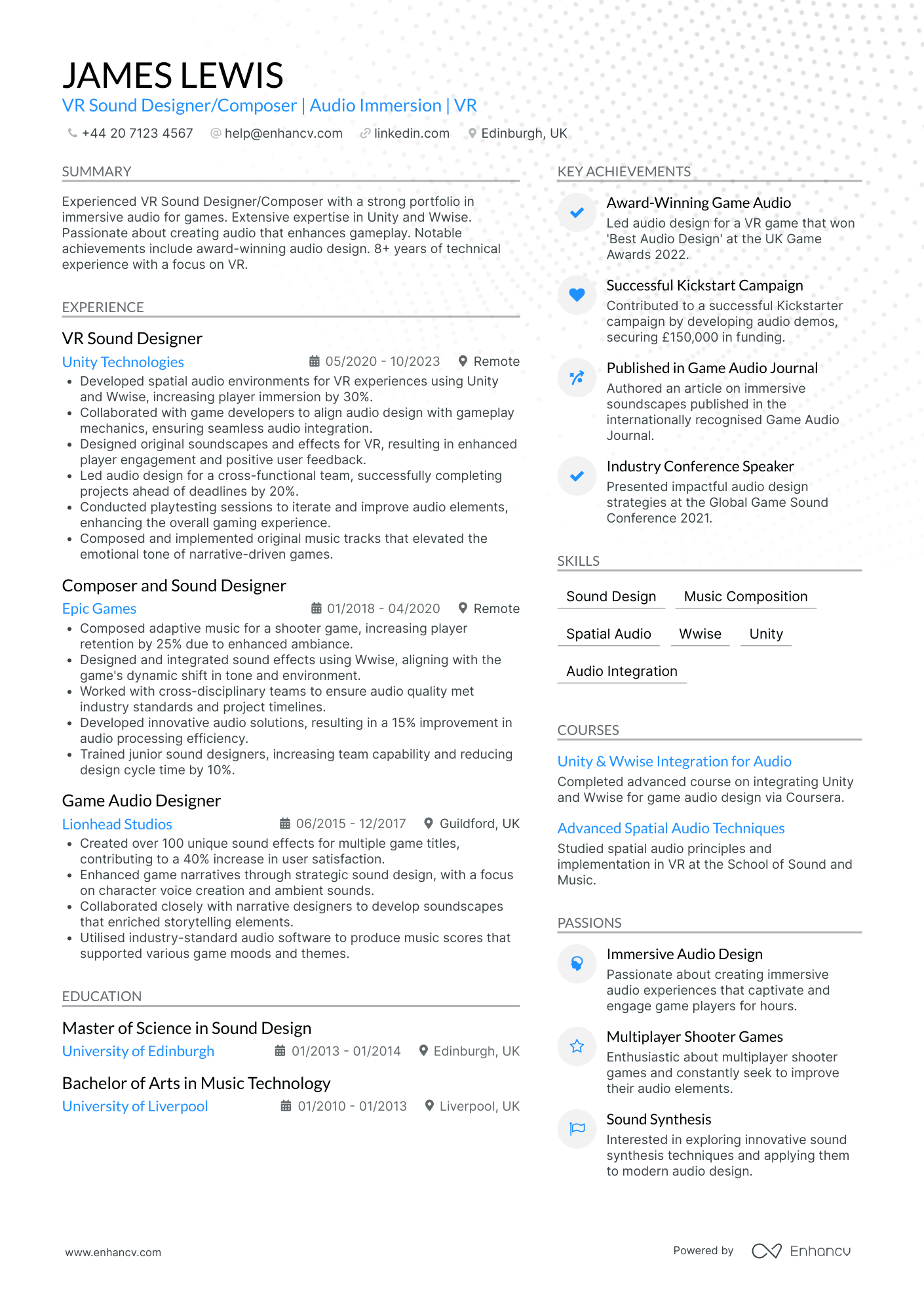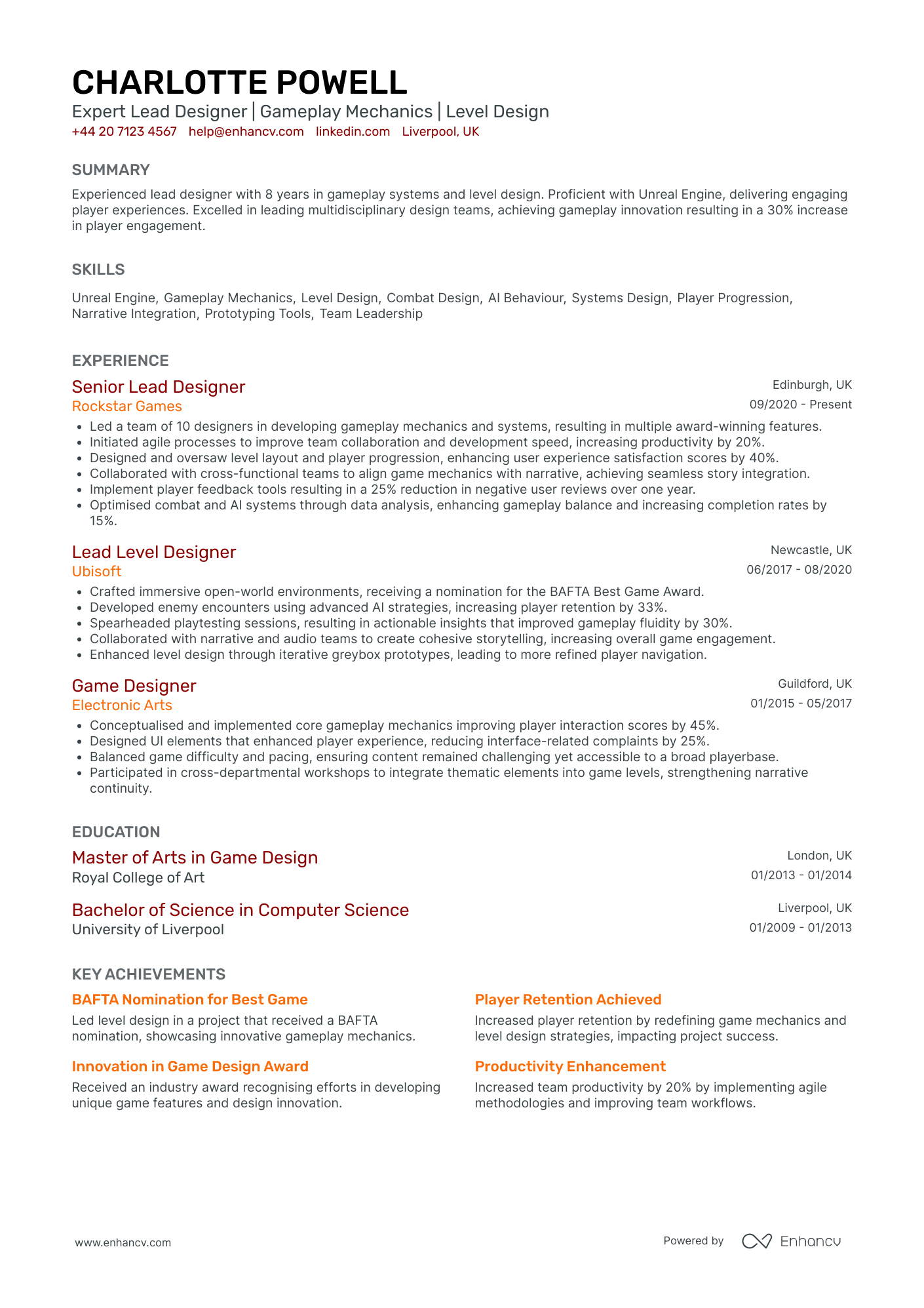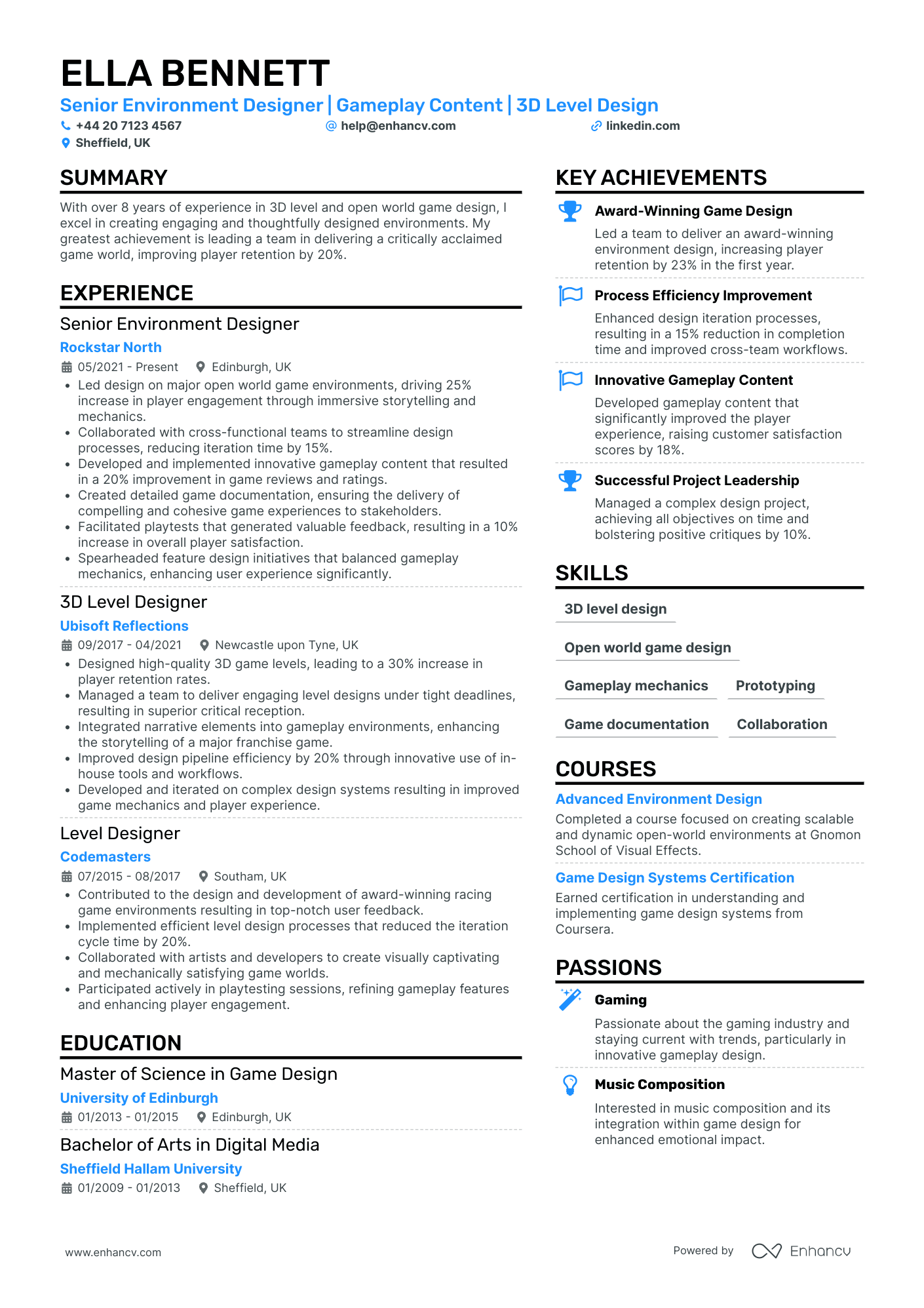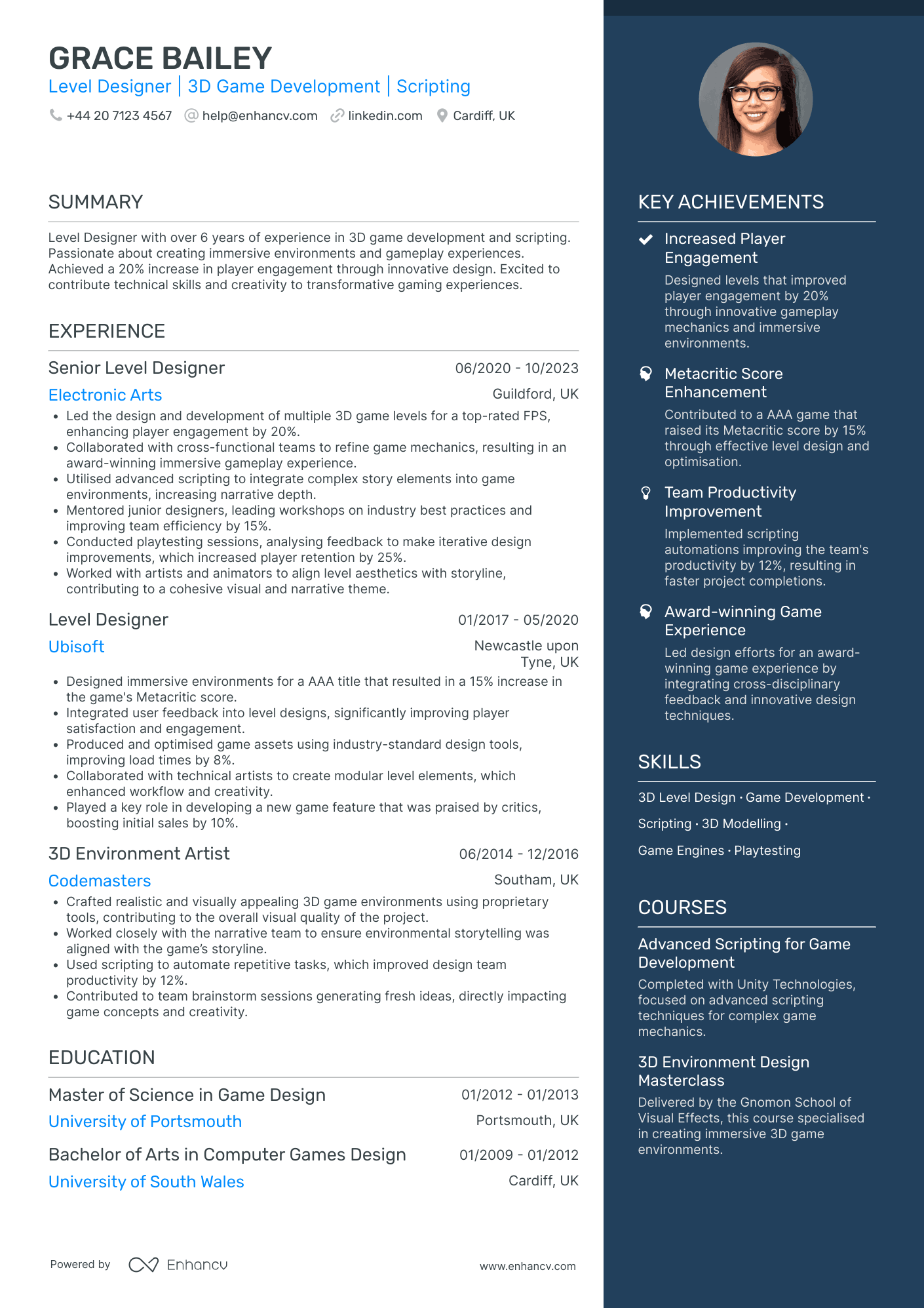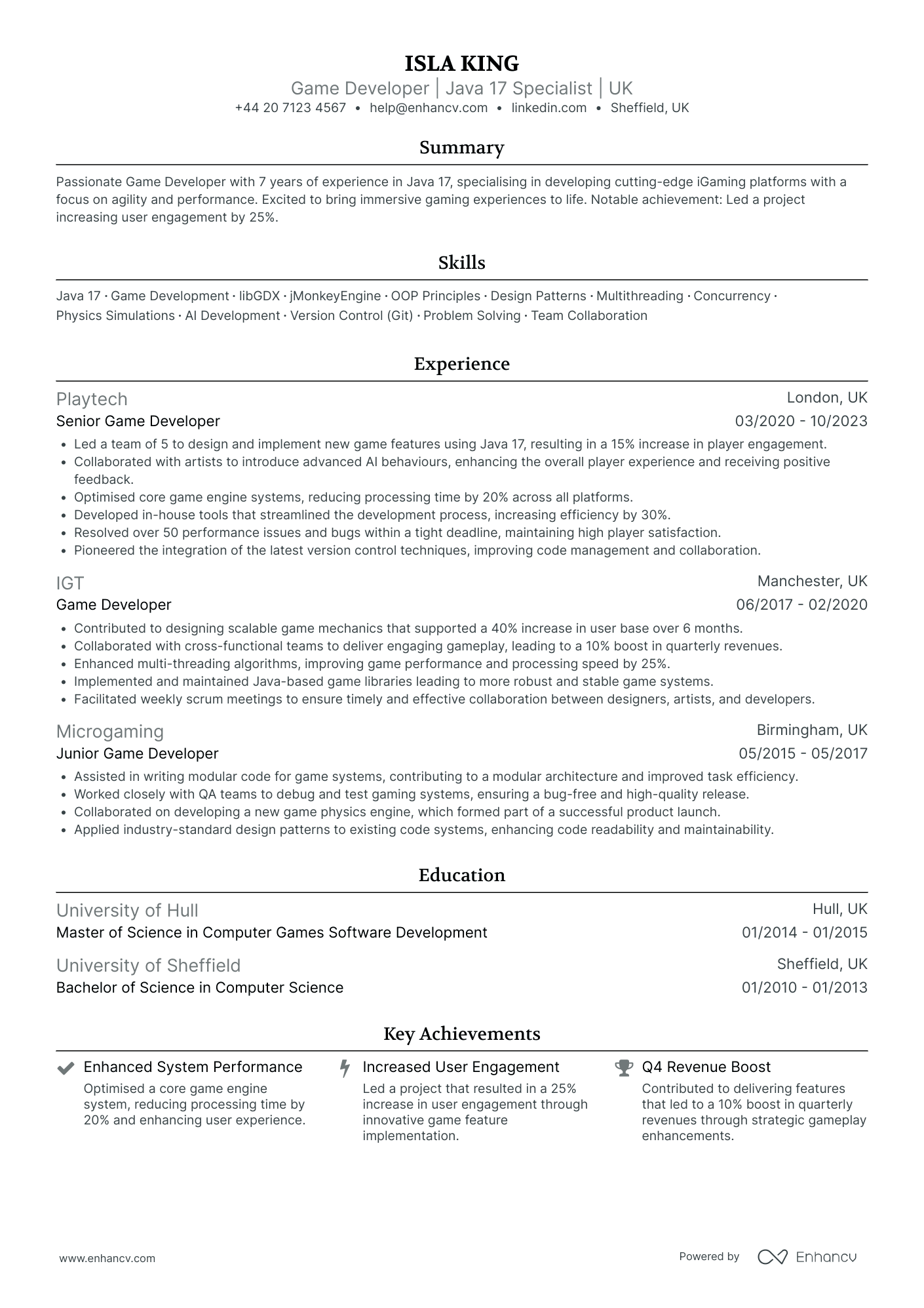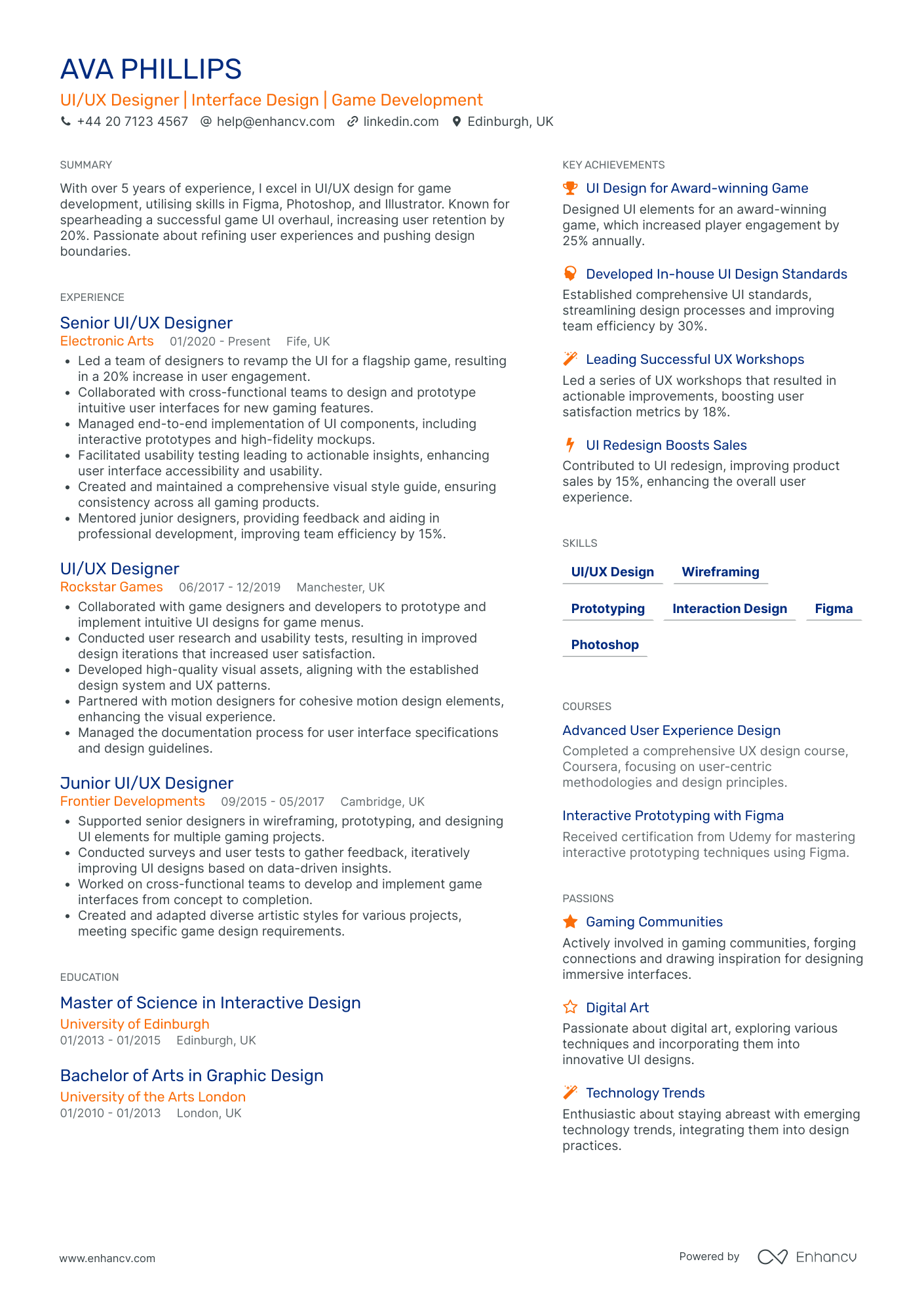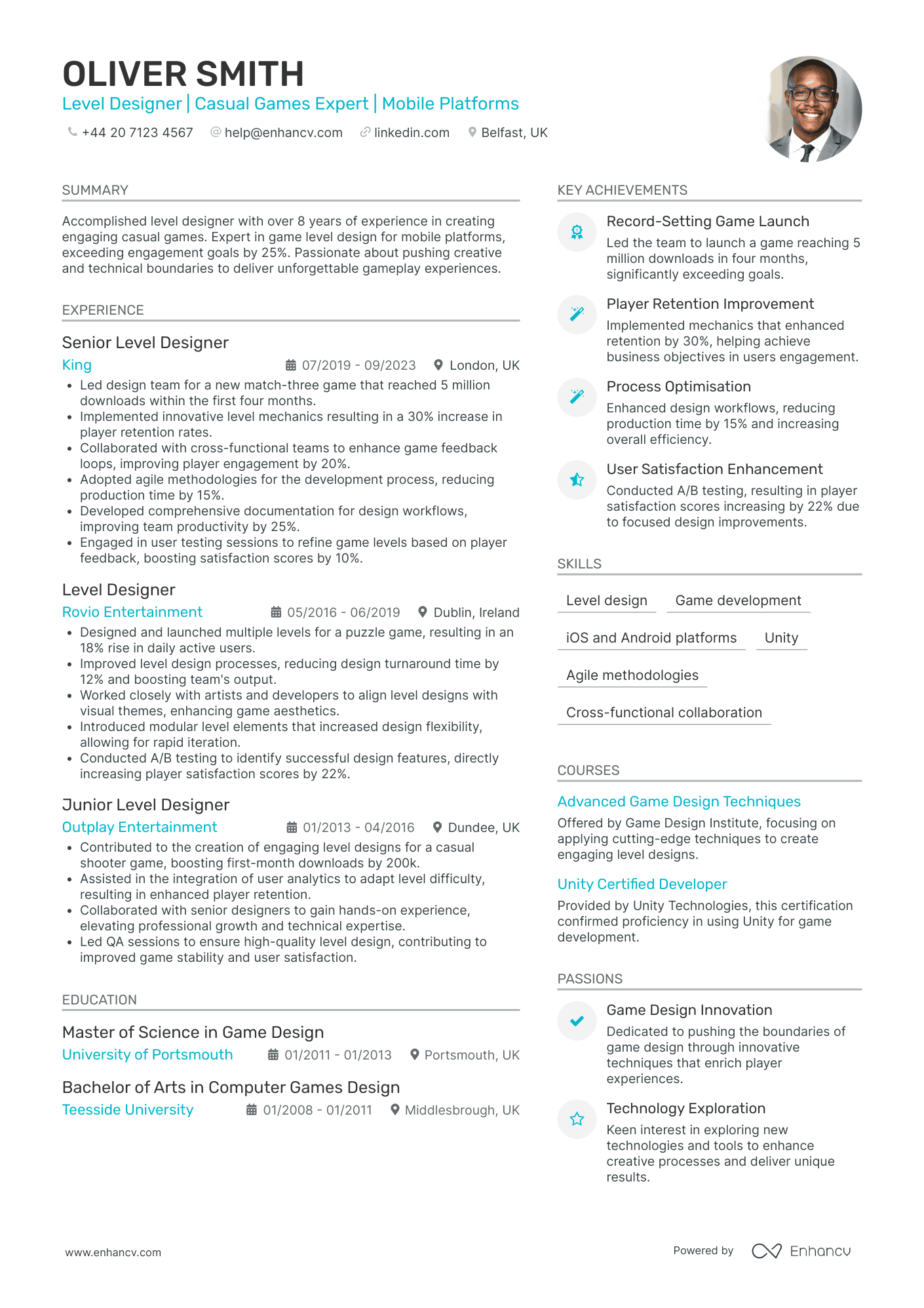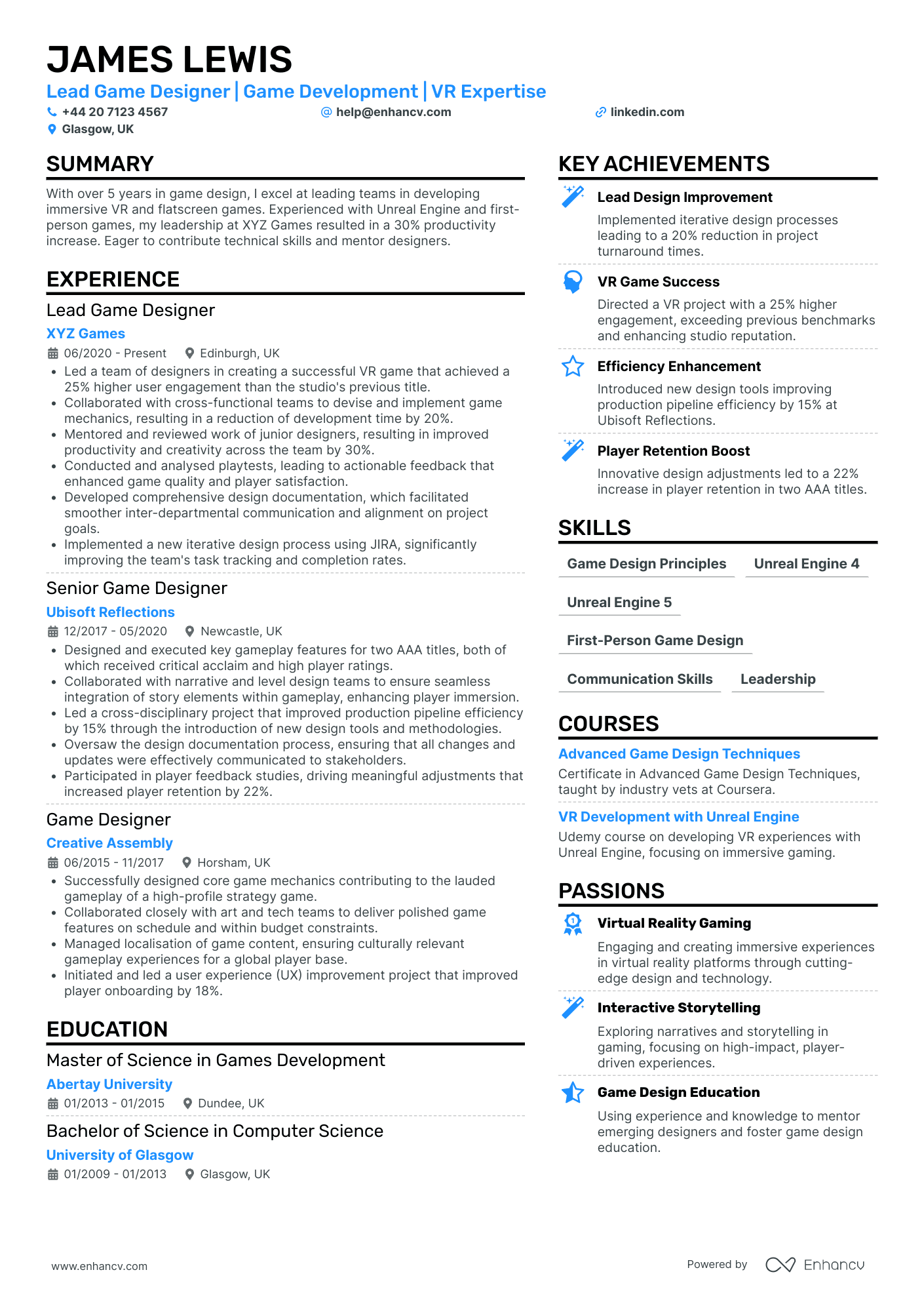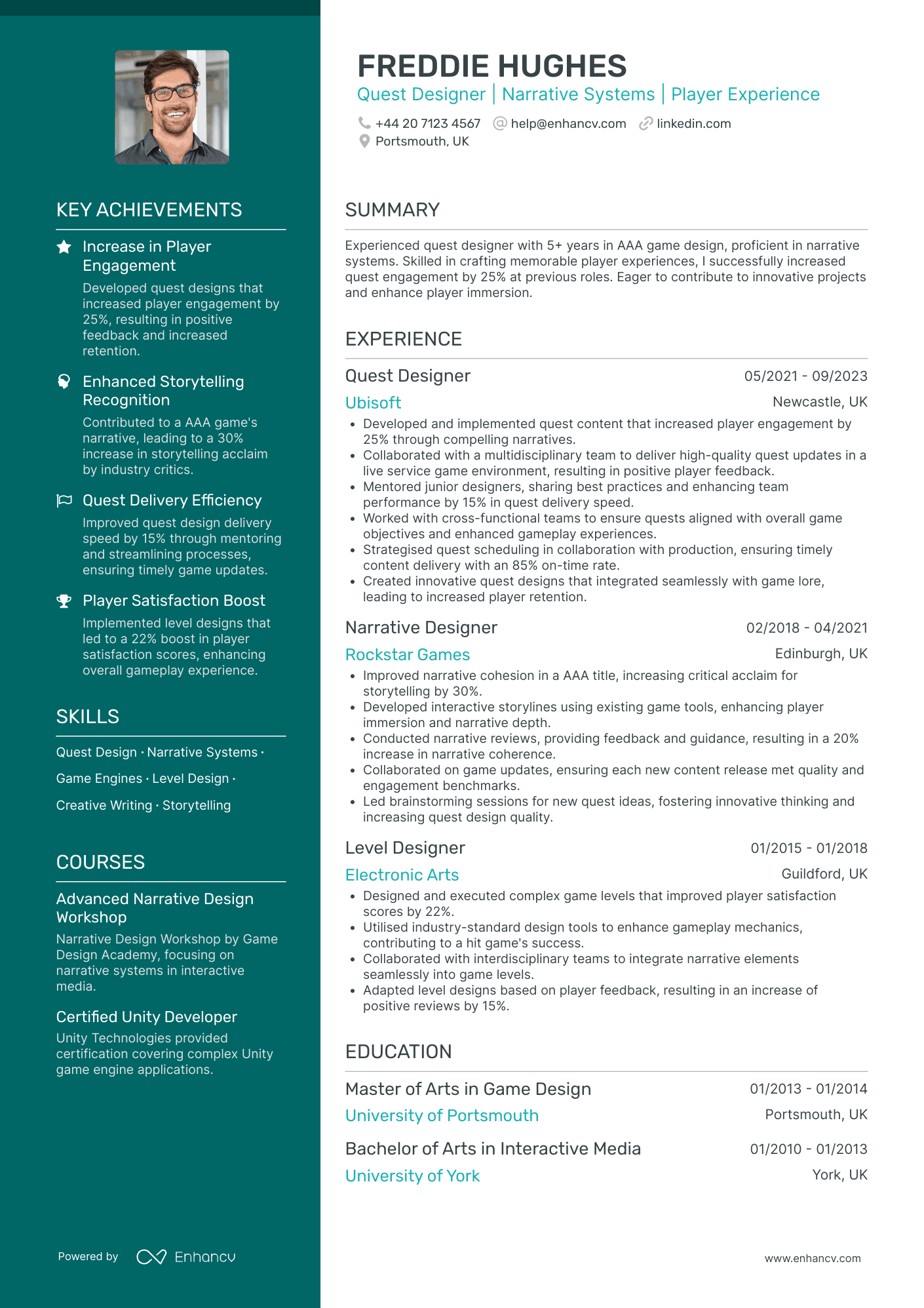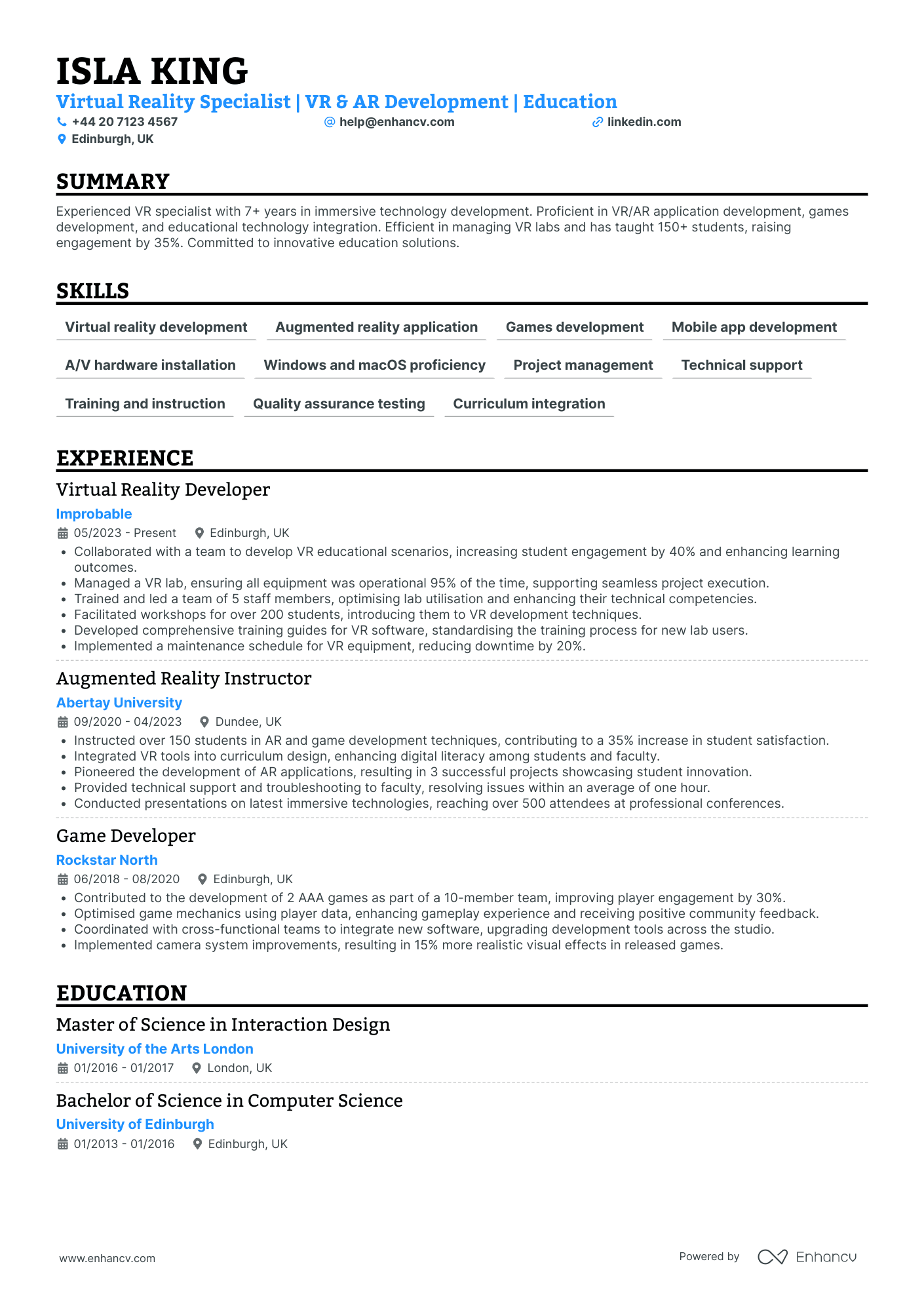Creating a compelling game world often requires meticulous attention to character variation, a CV challenge that can be daunting when seeking originality in design. Our guide provides robust frameworks and creative exercises that enable you to harness diverse inspiration and breathe life into your game's characters with unparalleled uniqueness.
- Applying the simplest CV design, so that recruiters can easily understand your expertise, skills, and professional background;
- Ensuring you stand out with your header, summary or objective statement, and a designated skills section;
- Creating your CV experience section - no matter how much expertise you have;
- Using real life professional CV examples to enhance the structure and outline of your profile.
If you still have no muse to write your professional CV, find some more industry-leading examples.
Resume examples for game designer
By Experience
Lead Game Designer
- Structured and Engaging Content Presentation - The CV skillfully arranges content for clarity and conciseness, making information easily digestible. Each section, from experience to key skills and achievements, is well-organized, allowing quick insights into Charlie's professional journey and capabilities.
- Career Growth in Prestigious Studios - Charlie's career trajectory shows a progressive path through some of the industry's top game studios, moving from Ubisoft to Rocksteady Studios, and then to a leadership role at Creative Assembly. This progression highlights a commendable rise in responsibilities and leadership within competitive environments.
- Demonstrated Technical Proficiency and Innovativeness - The CV highlights Charlie's command over industry-relevant tools and methodologies, such as Unity, Miro, and Confluence. This technical depth supports their role as a Lead Game Designer, alongside their initiative in implementing cutting-edge workflows and reducing project completion times by significant margins.
By Role
Mobile Game Designer
- Exceptional Career Growth - This CV showcases a clear and impressive career trajectory, moving from a Junior Game Designer to a Senior Mobile Game Designer at prominent companies. This progression emphasizes not only expertise in mobile game design but also a capacity for leadership and increased responsibility over time.
- Strong Industry-Specific Achievements - By highlighting achievements such as launching a game with 5 million downloads and successfully integrating monetization strategies that increased profitability by 25%, the CV demonstrates the candidate’s ability to deliver significant business impact and industry-leading results.
- Clear Skills and Methodologies - The CV details a broad array of technical skills, including proficiency in Unity and Adobe Creative Suite, and methodologies like game economy design and prototyping. These elements illustrate the candidate’s in-depth technical knowledge and their ability to execute complex game design projects effectively.
Game Level Designer
- Clear Structure and Concise Presentation - The CV excels in organizing information clearly and concisely. Sections are neatly divided into relevant categories such as experience, education, skills, and achievements, allowing for easy navigation. Each section is presented with brief, impactful details that quickly communicate the candidate's expertise and successes in level design.
- Career Growth and Industry Relevance - Samuel's career trajectory highlights significant growth from a Level Designer to a Senior Level Designer at King, an industry leader. This progression underscores his ability to deliver in increasingly challenging roles, showcasing his capability to adapt and excel within the gaming sector.
- Technical Mastery and Methodological Depth - The CV emphasizes Samuel's technical prowess in tools and methodologies specific to the gaming industry, such as Unity, visual scripting, and data analysis. This not only illustrates his technical competence but also his ability to apply these tools effectively to improve player engagement and satisfaction.
Game Systems Designer
- Well-defined career progression - Noah Jones' CV highlights a clear career trajectory, moving from a Junior Game Developer at Ubisoft Reflections to a Senior position at Playtech within a span of five years. This upward movement indicates both competence and an ability to grow professionally in the gaming industry.
- Adaptability across regions and roles - The transition from working at NetEnt in Stockholm to Playtech in Newcastle not only showcases Noah's geographical flexibility but also their capability to adapt to different cultural and corporate environments within the gaming sector.
- Extensive technical skill set relevant to gaming - Noah's proficiency in Java 17, libGDX, and jMonkeyEngine, coupled with a strong grasp of AI behavior and physics simulations, provides a robust technological foundation. This combination is particularly valuable for a game developer focused on delivering advanced gaming experiences.
Game Narrative Designer
- Structured Career Advancement - Noah Jones' CV highlights a strong upward trajectory in the narrative design industry, illustrating a clear path from Narrative Designer at Rocksteady Studios to a more senior position as a Senior Narrative Writer at Square Enix, ultimately achieving a leadership role in Narrative Design at Ubisoft. This reflects consistent growth and dedication to professional excellence.
- Diverse Industry-Specific Methodologies - The CV showcases sophisticated tools and methods specific to narrative design, such as innovative dialogue systems and strategic narrative feedback loops. These elements demonstrate Noah's expertise in the technical facets of narrative crafting and his ability to create unique and engaging gameplay experiences.
- Impactful Achievements with Quantifiable Results - Noah Jones highlights achievements tied directly to player engagement and retention metrics within the gaming industry. The CV details a 35% boost in player retention and a tangible increase in player engagement by 20%, underlining Noah's ability to not only meet but also exceed business objectives through narrative design.
Gameplay Designer
- Impressive Career Progression - Noah's career trajectory showcases a clear path of growth, from starting as a Game Designer at Ubisoft to becoming a Principal Player Combat & Gameplay Designer. This progression highlights his capability to take on increasingly complex roles and impact high-profile projects in the gaming industry.
- Unique Industry-Specific Expertise - Noah's CV stands out by detailing his expertise with tools and methodologies highly relevant to the gaming industry. His mastery of Unreal Engine, Blueprint Visual Scripting, and advanced AI integration illustrates his technical depth and readiness to innovate in game design.
- Effective Communication and Leadership - The CV highlights Noah's strong leadership and mentoring skills, having successfully mentored a team of designers, resulting in a 20% productivity improvement. This showcases his ability to motivate and develop team members, which is critical for maintaining high standards in collaborative game design projects.
Game UI Designer
- Emphasis on Career Progression - Sophia Foster's CV showcases a clear career trajectory, evidencing promotions and increasing responsibilities. From a UI/UX designer role at Ubisoft to a senior position at Electronic Arts, the CV reflects significant growth, illustrating a path of consistent advancement in high-profile companies.
- Strong Cross-Functional Collaboration - The CV highlights Sophia's adaptability and her capacity to work across different teams. Her ability to collaborate with developers, art teams, and outsource partners emphasizes her aptitude for cross-functional collaboration, crucial for executing successful design projects in the gaming industry.
- Impactful Achievements with Business Relevance - Foster's CV demonstrates her impactful contributions through significant business achievements. It mentions specific accomplishments like a 25% increase in user retention and a 15% rise in positive player feedback. These metrics not only showcase her effectiveness in enhancing user experience but also her role in driving business success.
Game Art Designer
- Dynamic career progression with notable industry impact - Harry's career trajectory showcases a clear path of growth from an Assistant Game Designer to a Senior Game Designer at prominent companies like Ubisoft and Rockstar Games. This progression highlights his increasing responsibilities and leadership capabilities, as demonstrated by his role in leading teams and producing critically acclaimed titles.
- Demonstrates strategic technical proficiency and innovation - The CV provides a detailed account of Harry's expertise in Unreal Engine 5 and advanced 3D development techniques, emphasizing unique industry-specific elements. His contribution to enhancing visual fidelity and integrating new art styles shows his technical depth, driving significant player engagement and satisfaction.
- Evidence of cross-functional collaboration and leadership - Harry's experience reflects strong collaboration skills, as he has worked extensively with cross-functional teams, including art and technical departments, to streamline processes and improve workflow. His leadership in facilitating workshops and mentoring junior artists demonstrates his ability to enhance team proficiency and foster a culture of continuous learning.
Game Audio Designer
- Content presentation offers clarity and depth - This CV is structured to provide clear insight into the candidate's expertise, presenting information in a concise manner while also delving into specific technologies and methodologies critical to VR sound design. Each section is organized logically, aiding readability and comprehension for potential employers.
- Significant career trajectory illustrating growth - The progression from Game Audio Designer to VR Sound Designer demonstrates the candidate's upward career trajectory in the gaming industry. It signifies their ability to adapt to newer technologies and roles, showcasing growth and continued professional development in increasingly complex positions.
- Unique industry-specific tools and techniques - The CV highlights the candidate's mastery in using specialized tools such as Unity and Wwise, along with proficiency in spatial audio and adaptive music composition. This technical depth is vital in the VR industry and sets them apart as a well-versed professional capable of driving innovation within the field.
Game Character Designer
- Structured and concise presentation - The CV is well-organized, with clearly defined sections that make it easy to navigate through Charlotte Powell's extensive career. Each chunk of information is delivered succinctly, ensuring that vital details about her qualifications and achievements are readily accessible at a glance.
- Impressive career progression - Charlotte Powell’s career trajectory shows a steady progression, from Game Designer at Electronic Arts to her current role as Senior Lead Designer at Rockstar Games. This progression highlights her growth in the industry and her ability to adapt and thrive in dynamic game development environments, culminating in impactful leadership roles.
- Notable industry-specific expertise - The CV underscores an in-depth knowledge of industry-standard tools and methodologies such as Unreal Engine, agile processes, and advanced prototyping tools. Her focus on areas like gameplay mechanics and AI behaviour reflects her technical depth and innovative approach to game design.
Game Environment Designer
- Structured Career Advancement - The CV effectively illustrates Ella Bennett's career progression within the gaming industry, showing a clear path from Level Designer at Codemasters to her current role as Senior Environment Designer at Rockstar North. This progression highlights her ability to take on increasing responsibilities and her successful adaptation to new challenges over time.
- Industry-Specific Expertise - Bennett's CV offers detailed insights into her proficiency with 3D level design and open world game design, which are crucial for creating engaging player experiences. Her understanding of narrative integration and design pipelines indicates a technical depth essential for developing immersive environments in the gaming industry.
- Impactful Achievements - The document emphasizes achievements that carry significant business impact, such as improving player retention by 20% and leading design initiatives that enhanced user satisfaction. These accomplishments not only showcase her technical skills but also underline her contribution to the commercial success of the projects she has worked on.
Game Mechanics Designer
- Structured progression throughout career - The CV illustrates a clear and deliberate career path, showcasing Grace Bailey's development from a 3D Environment Artist to a Senior Level Designer. Each role demonstrates increased responsibility and influence, highlighting her ability to contribute to larger projects and mentor junior team members.
- Technical prowess with industry-standard tools - Grace's expertise with advanced scripting, 3D modeling, and game engines is a unique strength, as evidenced by her successful work on AAA titles and award-winning projects. Her qualifications from top institutions and specialized courses further underscore her technical depth and dedication to continuous learning.
- Impactful achievements with business relevance - The CV highlights significant accomplishments, such as her work leading to a 20% boost in player engagement and a 15% increase in a game's Metacritic score. These metrics demonstrate her ability to make valuable contributions to game design that resonate with both players and the market.
Game Animation Designer
- Clear and Structured Presentation - The CV is meticulously structured, with clear headings for each section, allowing easy navigation through the candidate's qualifications, experience, and achievements. This clarity ensures that potential employers can quickly find relevant information aligned with the job requirements.
- Solid Career Growth and Industry Engagement - Isla King's career trajectory evidences a clear progression from Junior Game Developer to Senior Game Developer, demonstrating accelerated growth and leadership capabilities. The experience spans prominent companies like Playtech, IGT, and Microgaming, reflecting sustained involvement in the gaming industry and adaptability to different organizational cultures.
- Technical Prowess and Specialized Skills - The CV highlights Isla's technical expertise with industry-specific tools such as libGDX and jMonkeyEngine, alongside proficiency in Java 17 and AI Development. This specialized knowledge is emphasized through achievements in optimizing game engine performance and innovative game mechanics, showcasing technical depth and a forward-thinking approach.
Game User Experience Designer
- Career Trajectory and Growth - Ava Phillips's CV illustrates a clear and impressive career progression from a Junior UI/UX Designer to a Senior role at a leading company like Electronic Arts. Her advancement highlights her growing responsibilities, leadership capabilities, and the acquisition of advanced skills, demonstrating a commitment to professional development within the niche field of game development.
- Technical Proficiency and Industry-Specific Skills - The CV emphasizes Ava’s technical depth, listing a strong proficiency in essential design tools such as Figma, Photoshop, and Illustrator, as well as advanced methodologies like interactive prototyping and user research. Her skill set is tailored to the intricacies of UI/UX design in game development, making her a highly specialized candidate for roles in this sector.
- Impactful Achievements - Ava’s achievements are not just impressive in terms of numbers but also for their business impact. She led a game UI overhaul that boosted user retention by 20% and contributed to award-winning game design, indicating her ability to significantly enhance user experience and contribute to the commercial success of her projects.
Game Puzzle Designer
- Clear Presentation and Structured Content - The CV is well-organized with distinct sections for experience, education, skills, and achievements, making it easy for potential employers to quickly assess Oliver Smith's qualifications. Bullet points in the experience section provide clarity and conciseness, effectively conveying key responsibilities and accomplishments.
- Impressive Career Growth and Specialization - Showing a clear trajectory from Junior Level Designer to Senior Level Designer at major companies like King and Rovio Entertainment, the CV reflects Oliver's professional growth and increasing responsibilities. His specialization in casual games for mobile platforms highlights a focused expertise valuable to potential employers in the gaming industry.
- Emphasis on Industry Tools and Methodologies - Oliver's proficiency in Unity, a key tool in game development, and his use of agile methodologies demonstrate his technical depth and adaptation to industry standards. His involvement in cross-functional collaboration further showcases his capability to integrate diverse aspects of game design, enhancing overall project success.
Game Multiplayer Designer
- Comprehensive Technical Expertise - The CV effectively demonstrates James' proficiency with industry-standard tools such as Unreal Engine 4 and 5, essential for VR and first-person game development. This technical depth is crucial for a Lead Game Designer focused on creating immersive gaming experiences. His knowledge of iterative development and project management tools like JIRA and Perforce highlights his capability to streamline production processes efficiently.
- Leadership and Mentorship Excellence - The document highlights James’ ability to lead and mentor, showcasing significant improvements in productivity and team creativity under his guidance at XYZ Games. His leadership qualities are further emphasized through his mentoring of junior designers, showcasing his commitment to fostering a positive and productive work environment. This is crucial for a Lead Game Designer role where not only technical expertise but also strong leadership capabilities are essential.
- Strategic Career Development - James' career progression shows a strategic ascent in the gaming industry. Starting as a Game Designer at Creative Assembly, steadily advancing to a Senior role at Ubisoft Reflections, and achieving a Lead position at XYZ Games, his trajectory evidences a consistent climb through elevated responsibilities. This growth trajectory illustrates his dedication and competence, positioning him as a valuable asset in game design leadership.
Game Quest Designer
- Effective Content Presentation - The CV presents the information in a highly organized manner, making it easy to understand and navigate. Each section is clearly defined and concise, allowing for quick comprehension of the candidate's qualifications and achievements.
- Diverse Career Trajectory - Freddie Hughes' career progression showcases growth and specialization within the game design industry. From a Level Designer at Electronic Arts to a Quest Designer at Ubisoft, the trajectory indicates a focus on enhancing narrative systems and improving player experiences.
- Cross-Functional Collaboration - The CV emphasizes Freddie's ability to work effectively within multidisciplinary teams. Through experiences in different roles, including mentoring junior designers and collaborating with cross-functional teams, Freddie has demonstrated adaptability in various game development environments.
Game Virtual Reality Designer
- Impressive career trajectory and leadership - Isla King's career progression from a Game Developer at Rockstar North to a highly specialized Virtual Reality Developer at Improbable shows a clear upward trajectory in terms of responsibility and technical depth. Her role as an Augmented Reality Instructor at Abertay University also highlights her leadership abilities and dedication to shaping new talent in the field of immersive technology.
- Unique industry-specific elements - The CV highlights Isla's expertise in the integration of cutting-edge VR and AR tools into educational settings. Notably, her work involves managing VR labs, creating comprehensive training guides, and optimizing lab operations, showcasing a substantial depth in technical handling and innovative use of virtual tools.
- Achievements with significant business impact - The document is rich with achievements that clearly demonstrate Isla’s ability to drive value. For instance, her contribution to a 40% increase in student engagement and her leadership in launching successful AR projects underline her capacity to translate technical skills into impactful educational outcomes, benefitting both academic institutions and students.
Structuring and formatting your game designer CV for an excellent first impression
The experts' best advice regarding your CV format is to keep it simple and concise. Recruiters assessing your CV are foremost looking out for candidates who match their ideal job profile. Your white space, borders, and margins. You may still be wondering which format you need to export your CV in. We recommend using the PDF one, as, upon being uploaded, it never alters your information or CV design. Before we move on to the actual content of your game designer CV, we'd like to remind you about the Applicant Tracker System (or the ATS). The ATS is a software that is sometimes used to initially assess your profile. Here's what you need to keep in mind about the ATS:
- All serif and sans-serif fonts (e.g. Rubik, Volkhov, Exo 2 etc.) are ATS-friendly;
- Many candidates invest in Arial and Times New Roman, so avoid these fonts if you want your application to stand out;
- Both single and double column CVs can be read by the ATS, so it's entirely up to you to select your CV design.
PRO TIP
For certain fields, consider including infographics or visual elements to represent skills or achievements, but ensure they are simple, professional, and enhance rather than clutter the information.
The top sections on a game designer CV
- Profile Summary: Offers a snapshot of your design expertise and creativity.
- Game Design Experience: Showcases relevant projects and knowledge in game mechanics.
- Technical Skills: Lists software and programming mastery needed in game development.
- Education and Training: Details qualifications specific to game design and related fields.
- Portfolio Link: Provides direct access to your work for practical evaluation.
What recruiters value on your CV:
- Demonstrate your creative process by including a portfolio link or case studies of games you’ve designed, focusing on your role in developing game mechanics, narratives, and user experiences.
- Highlight any technical skills such as proficiency in game development engines (e.g., Unreal Engine, Unity), scripting languages (e.g., C#, JavaScript), or design software (e.g., Adobe Creative Suite), which are essential tools for game designers.
- Emphasise your understanding of game design principles and your ability to create engaging player experiences by referencing your knowledge of user-centred design, playtesting, and balancing gameplay.
- Include any collaborative projects or team leadership experience to showcase your ability to work effectively within multidisciplinary teams, which is a critical aspect of game development.
- Mention any industry recognition or awards you’ve received for your work, as this can differentiate you and demonstrate a track record of creating successful and noteworthy games.
Recommended reads:
Making a good first impression with your game designer CV header
Your typical CV header consists of Your typical CV header consists of contact details and a headline. Make sure to list your professional phone number, email address, and a link to your professional portfolio (or, alternatively, your LinkedIn profile). When writing your CV headline , ensure it's:
- tailored to the job you're applying for;
- highlights your unique value as a professional;
- concise, yet matches relevant job ad keywords.
You can, for examples, list your current job title or a particular skill as part of your headline. Now, if you decide on including your photo in your CV header, ensure it's a professional one, rather than one from your graduation or night out. You may happen to have plenty more questions on how to make best the use of your CV headline. We'll help you with some real-world examples, below.
Examples of good CV headlines for game designer:
- Lead Game Designer | AAA RPG Expert | UX/UI Enthusiast | 10+ Years Experience
- Senior Level Designer | Open-World Speciality | Certified Gameplay Innovator | 8 Years Crafting Worlds
- Game Mechanics Guru | Junior Game Designer | BA in Game Development | AI & Balancing Passion
- Narrative Director | Story-Driven FPS Crafting | 12 Years Industry Narrative | MFA in Creative Writing
- Virtual Reality Game Designer | Immersive Experiences | 5+ Years in VR Development | Haptic Feedback Advocate
- Multiplayer System Architect | Strategy Game Specialist | Procedural Generation Maestro | Senior Designer | 15 Years Experience
Catching recruiters' attention with your game designer CV summary or objective
Located closer to the top of your CV, both the summary and objective are no more than five sentences long and serve as an introduction to your experience. What is more, you could use either to entice recruiters to read on. Select the:
- Summary, if you happen to have plenty of relevant experience. Feature your most impressive accomplishments and up to three skills that are relevant to the job you're applying for;
- Objective, if you're just starting your career off. Provide your career goals and answer how you see the role you are applying for will match your professional growth.
Judging which one you need to add to your game designer CV may at times seem difficult. That’s why you need to check out how professionals, with similar to your experience, have written their summary or objective, in the examples below:
CV summaries for a game designer job:
Narrating the details of your game designer CV experience section
Perhaps you've heard it time and time again, but, how you present your experience is what matters the most. Your CV experience section - that details your work history alongside your accomplishments - is the space to spotlight your unqiue expertise and talents. So, avoid solely listing your responsibilities, but instead:
- adverts' keywords and integrate those in your experience section;
- Use your CV to detail how you've been promoted in the past by including experience in the reverse chronological order.
Before you start writing your game designer CV experience section, dive into some industry-leading examples on how to structure your bullets.
Best practices for your CV's work experience section
- Outlined the conceptualisation and development of game mechanics for 3 published indie games, demonstrating proficiency in balancing gameplay and player engagement.
- Collaborated with cross-functional teams, including artists and programmers, to integrate narrative and aesthetic elements into the gameplay, ensuring a seamless player experience.
- Implemented user feedback mechanisms and conducted playtesting sessions to gather data, enhancing gameplay based on actual user interactions and preferences.
- Led a design team through the full game development lifecycle, from initial brainstorming to post-launch support, meeting all project milestones and maintaining high team morale.
- Designed and iterated on complex game systems, utilising advanced mathematical models and algorithms to create engaging and balanced in-game economies.
- Authored comprehensive design documentation, including game concepts, mechanics, and story outlines, serving as a clear blueprint for all development stages.
- Regularly used industry-standard tools such as Unity and Unreal Engine, showcasing the ability to adapt to various development environments and requirements.
- Managed version control and workflow coordination with tools like Git and JIRA, ensuring efficient tracking of assets and tasks throughout the game development process.
- Presented game pitches and design visions to stakeholders and investors, effectively communicating the potential of game projects and securing necessary funding.
- Guided a team of 15 designers, ensuring consistent design language across all game levels, which led to a 30% increase in player retention for our flagship game 'Mythos Quest'.
- Orchestrated the integration of new motion capture technology, enhancing character realism and saving 20% of allocated budget due to increased animation efficiency.
- Piloted a user feedback loop for early game prototypes which amplified player engagement and contributed to a 50% reduction in negative reviews on the game's release.
- Led the conceptualisation and story development for 'Starlight Ventures', which sold over 1 million copies in the first quarter post-launch.
- Introduced a peer-review workflow process that cut down the prototyping phase by 25%, accelerating time-to-market for new game concepts.
- Managed cross-functional teams across narrative, art, and programming to ensure a cohesive game environment, culminating in a nomination for the BAFTA Games Award for Best Game Design.
- Developed and implemented a dynamic game difficulty adjustment system that reacted to player skill, significantly reducing churn rates by 35%.
- Spearheaded a collaboration with the marketing team to create in-game events aligned with seasonal promotions, yielding a 40% spike in microtransaction sales.
- Authored a set of best practice guidelines for level design that became the company standard, improving production consistency across projects.
- Designed an award-winning game world for 'Aether Chronicles', which generated over £5 million in revenue within the first six months after launch.
- Initiated and managed a successful partnership with an external VR studio to expand our game portfolio into the virtual reality space.
- Crafted a patented procedural generation algorithm that cut down content creation timelines by 60%, dramatically increasing studio output capacity.
- Collected and analysed gameplay data to refine the balance of 'Galaxy Defender', resulting in a strategic overhaul that saw a 80% improvement in player versus player (PVP) engagement.
- Managed the development lifecycle for 3 major game updates, directly contributing to a 120% rise in daily active users.
- Led a task force to identify and fix bottlenecks in the game development pipeline, which led to a sustained 15% improvement in productivity.
- Invented a unique game mechanic for 'Inferno Racer', which became viral on social media and resulted in a 200% jump in game downloads.
- Streamlined the character progression system for better user experience, which retained 50% more players during the critical first 30 days post-launch.
- Implemented A/B testing for new features, which allowed for data-driven design decisions that improved overall user satisfaction by 45%.
- Contributed to the level design of 'Chronicles of Elyria', helping the game to be recognized as the 'Debut Game of the Year' at the TIGA Awards.
- Assisted with the implementation of a dynamic weather system that increased the immersive quality of the game environment by 70% as reported by player surveys.
- Supported the senior design team in balancing game mechanics, leading to a more competitive and fair multiplayer experience and a 60% decrease in player complaints about balance issues.
- Advised on the monetization strategy of 'Fantasy Skies', influencing key design decisions that resulted in a month-on-month revenue growth of 25%.
- Led creative workshops that generated 5 new intellectual properties, securing funding for three high-potential projects and diversifying the studio's portfolio.
- Devised a comprehensive player retention framework that increased retention metrics by 40%, greatly enhancing the long-term profitability of key titles.
How to ensure your game designer CV stands out when you have no experience
This part of our step-by-step guide will help you substitute your experience section by helping you spotlight your skill set. First off, your ability to land your first job will depend on the time you take to assess precisely how you match the job requirements. Whether that's via your relevant education and courses, skill set, or any potential extracurricular activities. Next:
- Systematise your CV so that it spotlights your most relevant experience (whether that's your education or volunteer work) towards the top;
- Focus recruiters' attention to your transferrable skill set and in particular how your personality would be the perfect fit for the role;
- Consider how your current background has helped you build your technological understanding - whether you've created projects in your free time or as part of your uni degree;
- Ensure you've expanded on your teamwork capabilities with any relevant internships, part-time roles, or projects you've participated in the past.
Recommended reads:
PRO TIP
Include examples of how you adapted to new tools, environments, or work cultures, showing your flexibility.
Mix and match hard and soft skills across your game designer CV
Your skill set play an equally valid role as your experience to your application. That is because recruiters are looking for both:
- hard skills or your aptitude in applying particular technologies
- soft skills or your ability to work in a team using your personal skills, e.g. leadership, time management, etc.
Are you wondering how you should include both hard and soft skills across your game designer CV? Use the:
- skills section to list between ten and twelve technologies that are part of the job requirement (and that you're capable to use);
- strengths and achievements section to detail how you've used particular hard and soft skills that led to great results for you at work;
- summary or objective to spotlight up to three skills that are crucial for the role and how they've helped you optimise your work processes.
One final note - when writing about the skills you have, make sure to match them exactly as they are written in the job ad. Take this precautionary measure to ensure your CV passes the Applicant Tracker System (ATS) assessment.
Top skills for your game designer CV:
Game Design Theory
Level Design
Programming Languages
Game Engine Proficiency
Prototyping
3D Modelling
Animation
User Interface Design
Scripting
Gameplay Mechanics Development
Creativity
Communication
Problem-Solving
Teamwork
Attention to Detail
Time Management
Adaptability
Critical Thinking
Passion for Gaming
Narrative Skills
PRO TIP
If there's a noticeable gap in your skillset for the role you're applying for, mention any steps you're taking to acquire these skills, such as online courses or self-study.
Education and more professional qualifications to include in your game designer CV
If you want to showcase to recruiters that you're further qualified for the role, ensure you've included your relevant university diplomas. Within your education section:
- Describe your degree with your university name(-s) and start-graduation dates;
- List any awards you've received, if you deem they would be impressive or are relevant to the industry;
- Include your projects and publications, if you need to further showcase how you've used your technical know-how;
- Avoid listing your A-level marks, as your potential employers care to learn more about your university background.
Apart from your higher education, ensure that you've curated your relevant certificates or courses by listing the:
- name of the certificate or course;
- name of the institution within which you received your training;
- the date(-s) when you obtained your accreditation.
In the next section, discover some of the most relevant certificates for your game designer CV:
PRO TIP
Order your skills based on the relevance to the role you're applying for, ensuring the most pertinent skills catch the employer's attention first.
Recommended reads:
Key takeaways
Write your professional game designer CV by studying and understanding what the role expectations are. You should next:
- Focus on tailoring your content to answer specific requirements by integrating advert keywords through various CV sections;
- Balance your technical know-how with your personal skills to showcase what the unique value would be of working with you;
- Ensure your CV grammar and spelling (especially of your key information and contact details) is correct;
- Write a CV summary, if your experience is relevant, and an objective, if your career ambitions are more impressive;
- Use active language by including strong, action verbs across your experience, summary/objective, achievements sections.
